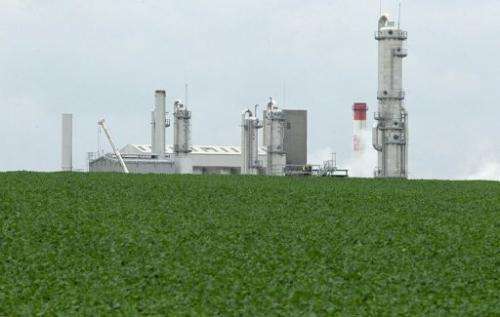View of a biorefinery in France. Biorefineries and "green chemistry" seem to have a credible future built on a wide range of applications such as cosmetics, plastics and detergents.
Biorefineries and "green chemistry" seem to have a credible future built on a wide range of applications such as cosmetics, plastics and detergents.
The rise of the price of oil and increasingly restrictive health legislation covering dangerous products are giving a boost to green refining.
Some "green chemistry" factories, a few of which exist in France, break down organic molecules found in wood, grain, and oil seeds, instead of using molecules derived from refined oil.
"The regulatory constraints are such that, together with the current cost of oil, it is already interesting for lubricants, resins and paints," said professor Daniel Thomas, vice president of the IAR competitivity centre in Picardie and Champagne in northwestern France. He was referring to the use of vegetable material in the refining process.
The European Commission directive known as Reach, which is due to result in a ban or drastic regulation of some chemical products such as phthalates, also opens the way to economically viable options for the use of other molecules derived from vegetable matter, leaders in the field meeting in Paris underlined.
In Europe 34 production facilities are considered to be biorefineries. There are five big centres in France, and the tally does not include laboratories or test laboratories.
Thomas said that "green chemistry is not a theoretical concept but is already a reality." He continued: "But it is true that this reality covers also the fact that the market is dependent on the price of oil, and that this border line is going to shift and so more and more molecules are going to become worthwhile."
For example, in the 1950s the price of a tonne of oil was one sixth of the price of a tonne of wheat. In 2011, oil was three times the price of wheat.
A study by consultants McKinsey has suggested that half of the inputs used by the chemicals industry could be in the form of vegetable matter by 2030, with the development of biocarburants such as lubricants, solvents and a concrete-like material made from wood for the construction industry, or plastic for bottles.
But this switch towards a chemical industry based on products from agriculture or forestry raises other problems: the use of land for purposes other than producing food could be a factor behind a rise of the prices of grains and vegetable oils and therefore of a large slice of what people eat.
These concerns recently put the brakes on the trend in France and possibly even more so throughout Europe concerning the first generation of products using the eatable part of plants.
Industrialists in the biorefining sector say that they are aware of this problem. Their development model is based on a doubling of agricultural production by 2050. But they hold that the impact of their activities on prices is minimal and that on the other hand they offer solution to dependence on oil.
"Without the first generation of biocarburants, we wouldn't be where we are today, talking about the second generation and about biorefineries," the head of the leading French organisation representing farmers FNSEA, Xavier Beulin said.
He said that France was developing a model based on supplies of raw materials from fields and forests close to the biorefinery in contrast to a model requiring the refinery to be close to a port.
In the second case, "the raw materials are imported with all sorts of implications," he said.
The president of the IAR, Dominique Dutarte, observed that only 4.0 percent of land cultivated in France was being used for biocarburants, and that "not so long ago, farmers had leave 10 percent of their land fallow."
(c) 2012 AFP




















